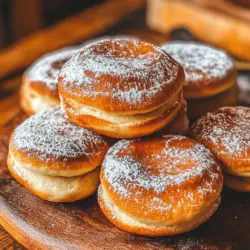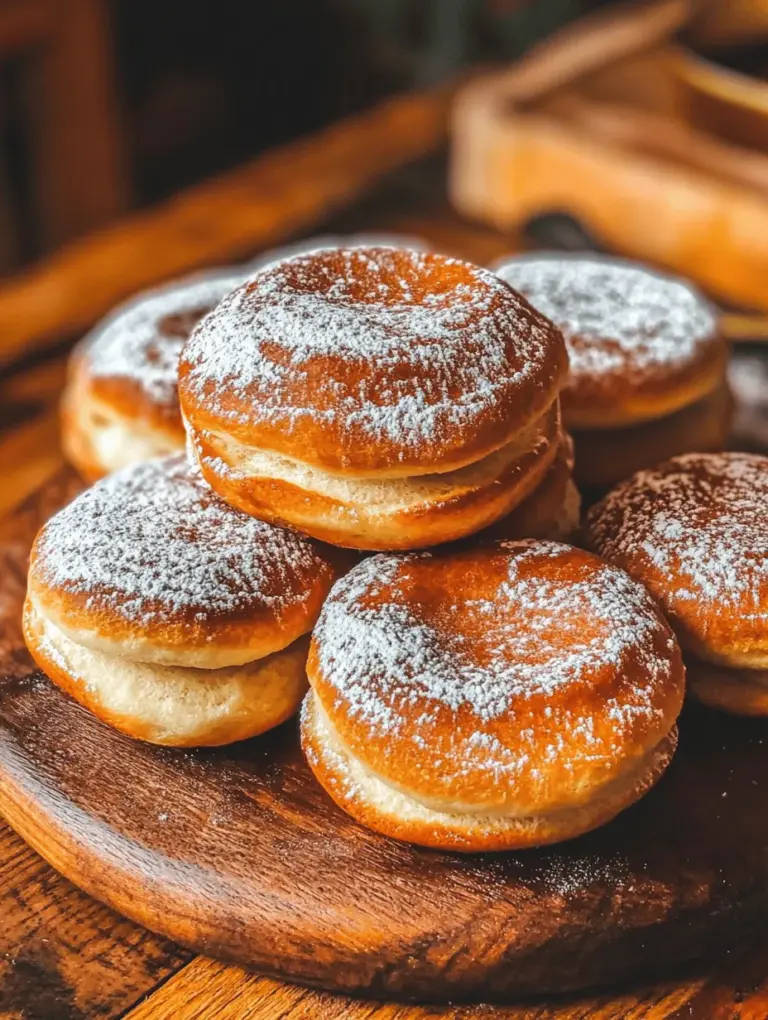Introduction
If you’re searching for a sweet indulgence that perfectly balances a tender, airy interior with a crisp, golden exterior, look no further than the delightful vanilla French beignet. Originating from France, these deep-fried pastries have captured the hearts (and taste buds) of many across the globe. Traditionally served dusted with powdered sugar, beignets are a beloved treat, often enjoyed for breakfast, dessert, or even as a delightful snack throughout the day.
The cultural significance of beignets cannot be understated. In French cuisine, they represent both simplicity and sophistication, often gracing tables during festive occasions, celebrations, and everyday life alike. Their light and fluffy texture, combined with a hint of vanilla, makes them a universally appealing choice. Furthermore, the popularity of beignets has soared beyond France, with variations popping up in various locales, particularly in New Orleans, where the beignet has become an iconic treat synonymous with the city’s culinary heritage.
What makes this recipe for vanilla French beignets so special is its accessibility. With just a handful of common ingredients, you can recreate these classic treats right in your own kitchen. Whether you’re looking to impress guests at brunch or simply satisfy your sweet tooth, this recipe is designed to guide you through every step of crafting these irresistible pastries at home.
Understanding Beignets
What Are Beignets?
At their core, beignets are French pastries that can be described as a type of fritter. The name “beignet” translates to “fritter” in English, emphasizing their fried nature. Typically, they are square or rectangular in shape, with a soft and airy interior that contrasts beautifully with their crispy exterior. While sweet beignets are perhaps the most well-known, savory variations do exist, often filled with ingredients like cheese or herbs.
Origins in French Culinary Tradition
The origins of beignets can be traced back to France, where they have been enjoyed for centuries. These pastries have undergone various incarnations over time, influenced by regional ingredients and culinary practices. In their sweet form, beignets are often associated with celebrations and street fairs, where they are freshly cooked and served hot. The tradition of enjoying beignets has also made its way into other cultures, with unique adaptations that reflect local tastes and ingredients.
Sweet vs. Savory Beignets
French beignets come in both sweet and savory forms, each offering a distinct flavor profile and experience. Sweet beignets, like the vanilla version we are focusing on, are typically flavored with ingredients like vanilla, chocolate, or fruit, making them a delightful dessert option. On the other hand, savory beignets can include fillings such as cheese, meat, or vegetables, making them suitable for appetizers or snacks.
In France, beignets can often be found at bakeries and cafes, and they hold a special place in festive celebrations, including Mardi Gras, when they are enjoyed as part of the festivities. This duality—being both a comforting everyday treat and a celebratory indulgence—cements beignets’ status as a culinary staple.
Ingredients Breakdown
To create your own batch of delightful vanilla French beignets, you’ll need the following ingredients. Each component plays a crucial role in achieving the perfect texture and flavor.
All-Purpose Flour
All-purpose flour forms the backbone of the beignet dough. It provides the structure necessary for the pastries to hold their shape while frying. The protein content in the flour helps develop gluten, which contributes to the chewiness of the beignets. Using a high-quality all-purpose flour will yield the best results.
Granulated Sugar
Granulated sugar is essential not only for sweetening the dough but also for enhancing the browning of the beignets during frying. The sugar caramelizes at high temperatures, creating a beautiful golden crust that adds to the visual appeal and flavor of the finished pastries.
Baking Powder
Baking powder serves as the leavening agent in this recipe. It helps the beignets rise as they cook, resulting in a light and airy texture. It’s important to use fresh baking powder for optimal results, as old or expired leavening agents may not provide the desired lift.
Salt
A small amount of salt is included in the dough to enhance the flavors of the other ingredients. Salt acts as a flavor enhancer, balancing the sweetness of the sugar and contributing to the overall taste of the beignets.
Unsalted Butter
Unsalted butter adds richness and flavor to the beignet dough. It also helps create a tender crumb, making the pastries even more enjoyable. By using unsalted butter, you can better control the saltiness of the final product.
Whole Milk
Whole milk brings moisture and creaminess to the dough, ensuring that the beignets are soft and tender. The fat content in whole milk also contributes to the overall richness of the pastries.
Eggs
Eggs play a vital role in binding the ingredients together and enriching the dough. They provide structure and stability, allowing the beignets to hold their shape while frying. Additionally, eggs contribute to the beautiful golden color of the finished pastries.
Vanilla Extract
The key flavor component in our vanilla French beignets is, of course, vanilla extract. This ingredient infuses the dough with a warm and aromatic flavor that pairs beautifully with the sweetness of the sugar. Opt for pure vanilla extract for the best flavor, as artificial extracts may not provide the same depth of taste.
Powdered Sugar
Powdered sugar is the finishing touch for our beignets. Once they are fried and cooled slightly, a generous dusting of powdered sugar adds sweetness and a beautiful presentation. The fine texture of powdered sugar creates that classic beignet look and feel.
Oil for Frying
Choosing the right oil for frying is crucial for achieving the perfect beignet. Vegetable oil or canola oil are both excellent options due to their high smoke points and neutral flavors. Using oil with a high smoke point helps prevent the beignets from absorbing too much oil during frying, ensuring they remain light and fluffy.
Preparation Steps
Now that we have a clear understanding of the ingredients needed for our delightful vanilla French beignets, let’s dive into the preparation steps. Follow this guide closely for the best results.
1. Gather Your Ingredients: Start by measuring out all the ingredients listed above. Having everything ready will make the process smoother and more efficient.
2. Mix Dry Ingredients: In a large mixing bowl, sift together the all-purpose flour, granulated sugar, baking powder, and salt. Sifting helps to aerate the flour, ensuring a light and fluffy dough.
3. Combine Wet Ingredients: In a separate bowl, whisk together the eggs, whole milk, melted unsalted butter, and vanilla extract until well combined. This mixture should be smooth and creamy, with the vanilla evenly distributed.
4. Blend Dry and Wet Ingredients: Gradually pour the wet mixture into the bowl of dry ingredients. Using a spatula or wooden spoon, gently mix until just combined. Be careful not to overmix; a few lumps in the batter are perfectly fine. Overmixing can lead to tough beignets, so aim for a light touch.
5. Prepare for Frying: Once your dough is ready, cover the bowl with plastic wrap or a clean kitchen towel, and let it rest for about 30 minutes. This resting period allows the gluten to relax, resulting in a more tender pastry.
6. Heat the Oil: While the dough is resting, it’s time to prepare for frying. In a deep pot or deep fryer, heat oil to 350°F (175°C). Use a candy thermometer to monitor the temperature, ensuring it stays consistent throughout the frying process.
7. Shape the Beignets: After the resting period, lightly flour a clean surface and turn the dough out onto it. Using a rolling pin, roll the dough to about ½ inch thickness. Cut the dough into squares or rectangles, approximately 2-3 inches in size. Alternatively, you can use a dough cutter or pizza cutter for this step.
8. Fry the Beignets: Once the oil has reached the desired temperature, carefully drop a few pieces of dough into the hot oil, being cautious not to overcrowd the pot. Fry the beignets for about 2-3 minutes on each side, or until they are golden brown and puffed. Use a slotted spoon to carefully flip them halfway through cooking for even browning.
By following these steps, you’ll be well on your way to creating delightful vanilla French beignets that are sure to impress your family and friends. Stay tuned for the next part of the article, where we’ll cover additional tips for achieving the best results and answer some common questions about this classic treat.
{{image_1}}
Step-by-Step Guide to Making Vanilla French Beignets
Creating delightful vanilla French beignets at home is a rewarding experience that can fill your kitchen with the sweet aroma of pastry. This guide will walk you through each step, ensuring you achieve fluffy, tender, and mouthwatering beignets that are perfect for any occasion.
Mixing Dry Ingredients for the Perfect Base
Start by gathering your dry ingredients. You will need:
– 2 cups all-purpose flour
– 1/4 cup granulated sugar
– 1 tablespoon baking powder
– 1/2 teaspoon salt
In a large mixing bowl, whisk together the flour, sugar, baking powder, and salt until they are well combined. This step is crucial as it ensures that the leavening agent is evenly distributed throughout the flour, which will help your beignets rise perfectly during frying.
Incorporating Butter for a Flaky Texture
Next, you will incorporate the butter, which is essential for achieving that signature flaky texture. Use 2 tablespoons of unsalted butter, softened to room temperature.
Cut the butter into small pieces and add it to the dry mixture. Using a pastry cutter or your fingertips, blend the butter into the flour mixture until it resembles coarse crumbs. This process allows small pockets of butter to remain in the dough, which will create a flaky texture when fried.
Creating the Wet Mixture and Combining with Dry Ingredients
In a separate bowl, prepare your wet ingredients. You will need:
– 1 large egg
– 1/2 cup whole milk
– 1 teaspoon pure vanilla extract
Whisk the egg, milk, and vanilla extract together until well blended. Slowly pour the wet mixture into the dry ingredients, stirring gently with a spatula or wooden spoon until just combined. The dough should be slightly sticky but manageable. Avoid overmixing, as this can lead to tough beignets.
Importance of Kneading the Dough Gently for a Tender Result
Once combined, transfer the dough to a lightly floured surface. With floured hands, gently knead the dough for about 1 minute. The goal here is to bring the dough together without overworking it, which can lead to dense beignets. The dough should be smooth and elastic but still soft.
Letting the Dough Rest and Rise for Optimal Fluffiness
After kneading, shape the dough into a ball and place it in a lightly greased bowl. Cover it with plastic wrap or a clean kitchen towel, and let it rest in a warm place for about 30 minutes. This resting period allows the gluten to relax and the leavening agents to activate, resulting in a fluffier beignet.
Rolling and Cutting the Dough: Tips for Uniformity
Once the dough has rested, it’s time to roll it out. On a well-floured surface, roll the dough to about 1/2 inch thickness. Use a sharp knife or a dough cutter to cut the dough into squares or rectangles, roughly 2-3 inches in size. For more uniform beignets, you can use a biscuit cutter or a square cutter.
Place the cut beignets on a parchment-lined baking sheet, making sure they are not touching, as they will expand while frying.
Frying Techniques: Temperature Control and Avoiding Overcrowding
Frying is where the magic happens! Use a deep fryer or a heavy-bottomed pot and fill it with about 2-3 inches of oil. Heat the oil to 350°F (175°C). It’s crucial to maintain this temperature throughout the frying process, as oil that is too hot will burn the beignets, while oil that is too cool will result in greasy, soggy pastries.
Importance of Oil Temperature: Maintaining the Right Heat for Frying
To ensure the oil is at the correct temperature, you can use a candy thermometer. If you don’t have one, drop a small piece of dough into the oil; if it sizzles and rises to the surface immediately, the oil is ready.
How to Tell When the Beignets Are Done: Visual and Tactile Cues
Once the oil is hot enough, carefully add the beignets in batches, making sure not to overcrowd the pot. Fry for about 2-3 minutes on each side or until they are golden brown and puffed up. Use a slotted spoon to flip them gently, ensuring even cooking. Once they are done, they should feel light and airy and be a lovely golden color.
Safety Tips for Frying: Preventing Burns and Ensuring Clean Frying
When frying, be cautious of hot oil splatters. Use a deep pot to minimize spills and keep a safe distance. Always have a lid nearby to cover the pot if necessary, and never leave hot oil unattended.
Options for Frying: Using a Deep Fryer vs. Stovetop Frying
While a deep fryer can provide consistent temperature control, you can achieve excellent results with a stovetop method. Just ensure your pot is deep enough to prevent oil from spilling over, and monitor the temperature closely.
Serving and Enjoying Beignets
Once your beignets are fried to perfection, it’s time to serve them up!
Best Practices for Serving Beignets: Freshness and Presentation
Beignets are best enjoyed fresh from the fryer. Place them on a wire rack covered with paper towels to drain excess oil. Dust them generously with powdered sugar while they’re still warm. For a delightful presentation, stack the beignets on a serving platter, and dust with more powdered sugar for an elegant finish.
Pairing Suggestions: Beverages and Additional Toppings
Beignets pair wonderfully with a variety of beverages. Consider serving them alongside a cup of rich coffee, hot chocolate, or a sweet vanilla latte. For a twist, you can also offer dipping sauces like chocolate ganache, caramel, or berry compote.
Storing Leftovers: How to Keep Them Fresh for Later Enjoyment
If you have any leftovers (which is unlikely!), store them in an airtight container at room temperature. They are best consumed within a day or two, but you can reheat them in a toaster oven to restore their fluffy texture.
Creative Serving Ideas: Transforming Beignets into a Dessert Platter
For a special occasion, consider creating a dessert platter featuring your beignets alongside other treats like fruit, whipped cream, or mini pastries. This adds variety and allows guests to enjoy a selection of delicious sweets.
Conclusion
Homemade vanilla French beignets are a delightful treat that can elevate any gathering or satisfy your sweet tooth at home. The process of making them is as enjoyable as the final product, allowing you to create a warm, comforting atmosphere filled with the scent of freshly fried pastries.
These beignets are not only a versatile dessert but also a wonderful addition to brunch or a festive celebration. Whether you serve them plain or with a variety of toppings, they are sure to impress your family and friends.
We encourage you to try this recipe and indulge in the sweet, fluffy goodness of homemade beignets. Enjoy the process and savor the delightful results!


